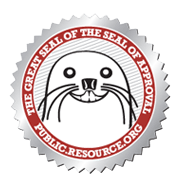Address
Text
Good morning. I’d like to thank David Ferriero for allowing us to Occupy NARA, and Maura Marx and John Palfrey for their tireless work organizing the DPLA over the last year. Most of all, I’d like to thank Robert Darnton, our prophet who is leading us to the promised land, the Republic of Letters. Bless me Professor, for I have scanned.
When I think about a Digital Public Library of America, two structures come to mind, I keep seeing images of reservoirs and bridges, when I think of the DPLA, I see the Hoover Dam and the Golden Gate Bridge.
If you look at our museums, our archives, our research institutions, there is a tremendous reservoir of knowledge locked up, waiting to be tapped. It is tempting to think that in our world of knowledge born digital, that we are flooded with information, that we need what Clay Johnson calls an information diet instead of more data. Our Internet is only flooded with some kinds of information.
Some of our most important pools of knowledge are not available at all, or available only to those with golden credit cards or positions of privilege in our elite institutions. Knowledge in our world belongs to the 1 percent.
I can give you two examples today of such private reserves, but I’m sure you can think of many more.
The first is law and government. The law—court opinions, statutes, regulations, public safety codes—is the operating system of our society, the rules that make our democracy work, the code that makes America such a special place.
But private fences have enclosed what should be the most public of public domains. Access to justice has become all about access to money.
Let me give you one more example. If you are a creative worker—a writer, a filmmaker, an artist, a scholar—you draw on imagery that has accumulated over thousands of years, imagery you use to create new works of art and scholarship. Creative workers must stand on the shoulders of giants if they are to reach new heights.
But, as any Hollywood filmmaker will tell you, much of that imagery is locked up in a few for-profit collections like Getty Images or Corbis or other operations that have taken public domain materials and built walls and gates around them. Even our museums—even our national Smithsonian Institution—have locked their vaults, allowing the images to be used only by those who stop by the cash register first.
There is a tremendous reservoir of untapped knowledge in America. Knowledge is our country’s most important renewable natural resource, a common pool that should be available to all.
We already have many beautiful museums, bottomless libraries, unique research institutions. What if the DPLA, instead of simply creating yet another institution, created that common reservoir that all could tap into? What if the Hathi Trust put everything they have into a common pool, a pool that they could in turn draw on to create an even more impressive Hathi Trust?
What if the Internet Archive and the Library of Congress and public libraries and individuals and local historical groups could all draw from those deep wells, all contribute to that common pool?
It is tempting for any one institution to say “I have the answer.” But, what if we shifted the debate, so that it becomes “We all have the answer, here’s my contribution, see what you can do with it. Surprise me!”
I have one more metaphor—and then I’ll stop beating this metaphorical horse—and that metaphor is a bridge, and the specific bridge I think of is a Washington Bridge, a bridge that connects our nation’s capitol to the rest of the country.
When it comes to untapped resources, Washington is surely the deepest well, a vast storehouse locked inside the beltway.
Look at our national cultural institutions—our Library of Congress, the National Library of Medicine, the Smithsonian Institution, the National Agricultural Library, the National Technical Information Service, the National Archives, and many more.
While we have glimpsed a few shining examples of the potential of our national cultural institutions—the American Memory project from the Library of Congress, the pioneering National Library of Medicine—for the most part our resources lay hidden.
Our opportunity is to build a bridge to Washington and that means we need to get much more serious about public works projects for knowledge, we need to start a national digitization initiative that is more than pilots and prototypes.
We need a decade-long commitment to scanning, we need our federal government to understand that it must deploy the Internet corps of engineers, to scan at scale, to become a much more serious contributor to that reservoir of knowledge, to be at the center of that public park that makes access to knowledge a right for all Americans, not a privilege for the 1 percent.
If a self-appointed librarian in an abandoned church like Brewster Kahle can publish 3 million books, how can our federal government not do more?
If Google can scan 10 million books just to feed its search engine, why can’t the federal government do the same to transform our nation’s educational system?
If WestLaw can scan the opinions of our courts and the statutes of our legislatures to maximize shareholder value, why can’t the Judicial Conference of the United States and our nation’s law schools work together to maximize democratic values?
If we can put a man on the moon, why can’t we launch the Library of Congress into cyberspace?
If billions of dollars can be spent to buy access to politicians, why can’t we spend billions of dollars to buy access to knowledge and justice, to promote the useful arts and commerce and science?
That is the challenge that we face, these are the kinds of bridges and reservoirs we can build, the kinds of public works projects that can become the foundation of a Digital Public Library of America, the opportunity we can realize, but only if we work together.
[ Direct Download PDF ]

